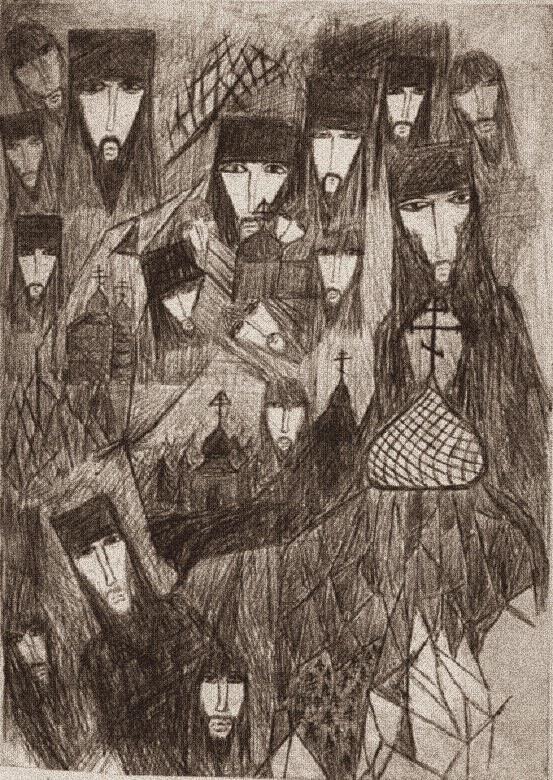UKRAINIAN ORTHODOX CHURCH IN AMERICA

GUIDELINES
FOR THE DEGREES OF MONASTIC CONSECRATION
Prerequisites for all candidates to the monastic life:
1. must be between the ages of 21 and 40, and must have, at the very minimum, a high school diploma,
2. must be a practicing Orthodox Christian for at least two years prior to applying for acceptance,
3. must be a citizen or legal permanent resident of the country in which the chosen monastery is located,
4. must be in good physical and mental health,
5. must be unmarried and free of both significant financial and family obligations,
6. must have an intense and healthy desire to serve Jesus Christ in a committed and unselfish way,
7. must be willing to live as a celibate and to serve in community,
8. must have a desire to live a life of prayer, in relationship with God, and must have the written recommendation of both his spiritual father and his pastor,
9. must be committed to living, in perpetuity, the vows of celibate chastity, poverty, obedience and stability of place.
Becoming a monk involves several years of discernment and formation.
POSTULANCY
The initial period is known as Postulancy and lasts for a period of not less than six months. This period is devoted to experiencing fraternal life with some opportunity to participate in ministry.
NOVITIATE
After the mandatory postulancy period of no less than six months, the ihumen may bless the candidate to become a novice. There is no formal ceremony for the tonsuring and clothing of a novice; he simply receives permission to wear the clothing of a novice, namely, the pidriasnik, skufia and monastic belt. The period of the novitiate focuses on an intense introduction to the spiritual life and the life of the monastic vows.
RASSOPHORE
If the novice continues on to become a monk, after a period of no less than one year and a majority vote of the monastic community, he is clothed in the first degree of monasticism at a service at which he is tonsured. Although there are no formal vows made at this point, the candidate is normally required to affirm his commitment to persevere in the monastic life for life. The ihumen will then perform the tonsure, cutting a small amount of hair from four spots on the head, forming a cross. He is then given the riassa and klobuk. Although the Rassophore does not make formal vows, he is still morally obligated to continue in the monastic estate for the rest of his life. Some will remain Rassophores permanently without going on to the higher degrees. During this period the monk’s spiritual and intellectual formation continues. The monk and the community reflect on his experience of living the vows and serving the People of God.
STAVROPHORE
No less than three years after the first tonsure and only when the ihumen feels that the monk has reached an appropriate level of discipline, dedication and humility, the monk may be admitted to the degree of Stavrophore. This degree is also known as the Small Schema, and is thought of as a "betrothal" to the Great Schema. At this stage, the monk makes formal, life-long vows of stability of place, chastity, obedience and poverty. He is then tonsured and clothed in the habit, which in addition to that worn by the Rassophore, includes the paraman (παραμανδυας), a piece of square cloth worn on the back, embroidered with the instruments of the Passion of Christ, and connected by ties to a wooden cross worn over the heart. The paraman (παραμανδυας) represents the yoke of Christ. Because of this addition he is now called Stavrophore, or Cross-bearer. He is also given a wooden hand cross which he should keep in the icon corner of his cell, and a beeswax candle, symbolic of monastic vigilance the sacrificing of himself for God. He will be buried holding the cross, and the candle will be burned at his funeral. The Stavrophore monk also wears the monastic mantiya, which symbolizes 40 days of the Lord's fasting on the Mountain of Temptation.
GREAT SCHEMA
After several years as a Stavrophore, monks whose ihumen feels that they have reached a high level of spiritual excellence reach the final stage, called the Great Schema. The tonsure of a Schemamonk follows the same format as the Stavrophore, and he makes the same vows and is tonsured in the same manner. But in addition to all the garments worn by the Stavrophore, he is given the analav (άνάλαβος) which is the article of monastic vesture emblematic of the Great Schema. For this reason, the analav (άνάλαβος) itself is sometimes itself called the "Great Schema.”
IHUMEN (ABBOT)
1. must never be granted as an “honorary” title or a stepping stone to the episcopacy (as in the Russian Church), but must be a true monk elected by his monastic community,
2. need not be a hieromonk or hierodeacon, but may be a lay monk,
3. must have been professed as a Schema Monk for not less than five years,
4. must be living in a community of no less than three monks,
5. must be a minimum of thirty-five years of age,
6. must be known for his holiness of life, patience, compassion, communication skills, administrative skills and leadership abilities.